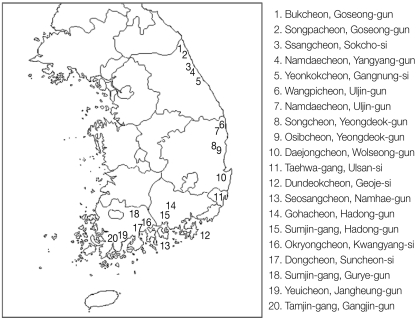Prevalence of Metagonimus Metacercariae in Sweetfish, Plecoglossus altivelis, from Eastern and Southern Coastal Areas in Korea
Article information
Abstract
The present study was performed to determine the current infecion status of Metagonimus yokogawai metacercariae in sweetfish, Plecoglossus altivelis, collected from several streams in eastern and southern coastal areas of Korea. The sweetfish collected were artificially digested with pepsin-HCl solution and examined under a stereomicroscope in August and September, 2007. Out of 145 sweetfish collected from 10 streams in eastern coasts (Gangwon-do and Gye-ongsangbuk-do), 88 (60.7%) were infected with Metagonimus metacercariae. The average metacercarial density was 61 per infected fish. Among 141 sweetfish collected from 10 streams in southern coasts (Gyeongsangnam-do, Ulsan Metropolitan city, and Jeollanam-do), 140 (99.3%) were infected with Metagonimus metacercariae, and their average density was 949 per infected fish. The present study confirmed that M. yokogawai metacercariae are still prevalent in the sweetfish from several eastern and southern coastal localities. The prevalence and metacercarial density were much higher in the sweetfish from streams of southern coasts than in those of eastern coasts. Therefore, attention should be paid to this small fluke infection, and consumption of raw sweetfish naturally produced in these areas should be prohibited.
INTRODUCTION
Flukes of the genus Metagonimus are minute parasites inhabiting the small intestines of birds and mammals, including humans [1]. They are widely distributed in the Republic of Korea (=Korea) and Japan [1]. These flukes give rise to severe gastrointestinal troubles and chronic diarrhea in heavily infected cases [1,2]. In Korea, a total of 11 species in 8 genera, i.e. Metagonimus yokogawai, Metagonimus takahashii, Metagonimus miyatai, Heterophyes nocens, Heterophyopsis continua, Stellantchasmus falcatus, Pygidiopsis summa, Centrocestus armatus, Strictodora fuscata, Stictodora lari and Acanthotrema felis, have been reported as human-infecting species of heterophyid flukes [1]. Among them, M. yokogawai is most important species based on the high prevalences and wide distribution in endemic areas, which is mainly located along the riverside areas in the eastern and southern coasts [1,3-5].
On the other hand, sweetfish, Plecoglossus altivelis, have been known as the major infection source of human metagonimiasis in Korea. Residents in endemic areas have popularly eaten raw flesh of sweetfish. Thus, epidemiological studies on the prevalence of Metagonimus metacercariae in sweetfish have been performed by many workers in eastern and southern coastal areas. However, most of these studies were performed in the limited endemic areas between 1960 and 1990, with the exception of Seo et al. (1982) and Song et al. (1985) [6-18]. Therefore, the present study was conducted to determine the current infection status of Metagonimus metacercariae in sweetfish collected from rivers and streams in the eastern and southern coastal areas of Korea.
MATERIALS AND METHODS
In August and September 2007, a total of 286 sweetfish, P. altivelis, were collected from 5 rivers or streams in Gangwon-do (79 fish; av. 18.0 cm long and 55.3 g in weight), Gyeongsangbuk-do (66 fish; 17.5 cm and 46.8 g), Gyeongsangnam-do and Ulsan Metropolitan city (87 fish; 19.2 cm and 65.7 g), and Jeollanam-do (54 fish; 19.1 cm and 57.6 g) (Fig. 1). The collected fish were transferred to our laboratory with ice, measured their length and weight, and examined with the artificial digestion method. Each fish was finely ground with a mortar with pestle or in a grinder, the ground fish flesh was mixed with artificial gastric juice, and the mixture was incubated at 36℃ for 2-3 hr. The digested material was filtered through a mesh of 1×1 mm, and washed with 0.85% saline until the supernatant became clear. The sediment was carefully examined under a stereomicroscope. Metagonimus metacercariae (almost all were M. yokogawai) were collected by their general morphologies, counted, and infection rates and intensities were then calculated.
RESULTS
Infection status of sweetfish from eastern coastal areas
Among 79 sweetfish collected from 5 streams in Gangwon-do, 44 (55.7%) were infected with Metagonimus metacercariae, and the average metacercarial number was 116 per infected fish. Out of 66 sweetfish collected from 5 streams in Gyeongsangbuk-do, 44 (66.7%) were positive of Metagonimus metacercariae, and the average metacercarial density was 6 per infected fish. In total, 60.7% sweetfish from eastern coastal areas were infected with 1-482 metacercariae (av. 61 per fish). The infection status of sweetfish by their collection sites is detailed in Table 1.
Infection status of sweetfish from southern coastal areas
All of the 87 sweetfish collected from 5 streams in Gyeongsangnam-do and Ulsan Metropolitan city were found infected with Metagonimus metacercariae, and the average metacercarial number was 846 per infected fish. In Jeollanam-do, 53 (98.1%) of 54 sweetfish collected from 5 streams were infected with Metagonimus metacercariae, and the average metacercarial density was 1,120 per infected fish. In total, 140 (99.3%) of 141 sweetfish collected from western coastal areas were infected with av. 949 metacercariae per infected fish. The infection status of sweetfish by their collection sites is shown in Table 2.
Comparison with previous studies
Overall, 228 (79.7%) out of 286 sweetfish examined were infected with Metagonimus metacercariae, and the average metacercarial burden was 607 per infected fish. This overall prevalence was higher than that (64.0%) reported previously by Song et al. [7]. However, the average metacercarial density per infected fish was slightly lower (788 metacercariae) than in Song et al. [7]. Comparative infection status in the sweetfish from 4 provinces is depicted in Table 3. The prevalence (60.7%) in the sweetfish from eastern coastal areas was lower than that (99.3%) from southn coastal area. The metacercarial density in the sweetfish from eastern coastal areas was much lower than that from southern coastal areas. These trends were identical to those of the previous studies (Table 4) [6,7].

Prevalence of Metagonimus metacercariae in sweetfish from 4 provinces in comparison with a previous study
DISCUSSION
Several research groups have examined the prevalence of Metagonimus metacercariae in sweetfish from Gangwon-do, [6,7,15-18]. In 1981, Song [15] reported the prevalence of 54.2% and average metacercarial density of 82 per infected fish among a total of 144 sweetfish from 11 streams in 5 localities. In 1982, Seo et al. [6] reported 33.3% and 913 metacercariae among 108 sweetfish from 4 streams. In 1984, Ahn [16] reported 100% prevalence and 382 metacercariae among 67 sweetfish from Osibcheon (stream) in Samcheok-gun. In 1985, Song et al. [7] found 46.4% prevalence and 129 metacercariae among 237 sweetfish from 20 streams. In 1987, Ahn et al. [17] reported 24% and 295 metacercariae among 50 sweetfish from 4 streams. In 1990, Sohn et al. [18] reported 82.4% and 224 metacercariae among 34 sweetfish from 2 streams. In the present study, 55.7% of sweetfish were infected with av. 116 Metagonimus metacercariae (almost all were M. yokogawai) per infected fish from 5 streams in Gangwon-do. Comparing our findings with those of previous studies, it turned out that the infection rate of sweetfish was more or less higher than before, while the metacercarial density was comparatively lower.
Regarding the infection status of Metagonimus metacercariae in sweetfish from Gyeongsangbuk-do, there were at least 4 studies [6,7,10,13]. In 1977, Hwang and Choi [10] reported 100% prevalence among a total of 128 sweetfish from 3 localities, i.e., Hyeongsan-gang (river), Osibcheon, and Yucheon, and the mean metacercarial density was 4,333 in 10 sweetfish. Other reports included Suh and Choi [13] who reported 100% prevalence among 77 sweetfish from Ahnseong-cheon (a total of 1,815 metacercariae from 13 sweetfish), Seo et al. [6] who reported 100% and 200 metacercariae among 17 sweetfish from Wangpicheon, Song et al. [7] who detected 50.9% and 527 metacercariae among 112 sweetfish from 12 streams. In the present study, 66.7% of sweetfish were infected with av. 6 Metagonimus metacercariae. Accordingly, the metacercarial density became remarkably lower than those of the previous studies.
There are 5 studies on the infection status of Metagonimus metacercariae in sweetfish from Gyeongsangnam-do and Ulsan Metropolitan city [6-9,14]. In 1960, Chun [8] reported 37 metacercariae per infected fish among 100 sweetfish from Milyang-gang. In 1969, Hong and Seo [9] reported 100% prevalence and av. 3,851 metacercariae among 10 sweetfish from Sumjin-gang in Hadong-gun. In 1979, Kim et al. [14] reported 100% prevalence and av. 2,455 metacercariae among 14 sweetfish from Sumjin-gang in Hadong-gun. In 1982, Seo et al. [6] reported 100% prevalence and av. 14,143 metacercariae among 56 sweetfish from 3 streams. In 1985, Song et al. [7] reported 67.6% prevalence and av. 1,675 metacercariae among 94 out of 139 sweetfish examined from 17 streams. In our study, we found 100% prevalence and av. 846 metacercariae among 87 sweetfish from 5 streams in Gyeongsangnam-do and Ulsan Metropolitan city. Therefore, the metacercarial density in our study was somewhat lower than in previous studies.
With regard to the infection status of Metagonimus metacercariae in sweetfish from Jeollanam-do, 4 studies were available [6,7,11,12]. In 1977, Chai et al. [11] reported 100% infection rate and av. 15,688 metacercariae among 20 sweetfish from a water reservoir nearby the Tamjin river, Jangheung-gun. In 1978, Soh and Ahn [12] reported 100% prevalence and av. 22,650 metacercariae among 12 sweetfish from Boseong-gang in Boseong-gun. In our study, all 12 sweetfish from Dongcheon, Sooncheon-si were infected with av. 397 Metagonimus metacercariae, and this was comparable with Song et al. [17], in which all 16 fish were infected with av. 718 metacercariae per sweetfish. Similarly, in sweetfish from Sumjin-gang in Gurye-gun, 19 (95%) of 20 were infected with av. 1,511 Metagonimus metacercariae in the present study, whereas all 5 fish were infected with av. 2,412 metacercariae in a previous study [7]. In sweetfish from Tamjin-gang in Gangjin-gun, all 16 were infected with av. 1,037 Metagonimus metacercariae in the present study, whereas all 16 were infected with av. 14,887 metacercariae in a previous report [6], and 11 (92.3%) of 12 fish were infected with av. 636 metacercariae in another report [7].
From the present study, it is confirmed that Metagonimus metacercariae are still prevalent in the sweetfish from many streams in southern and eastern coastal areas of Korea. The prevalence and intensity of metacercariae in sweetfish from streams of southern coasts were much higher than in sweetfish from eastern coasts. These trends were also reported in previous studies [6,7]. The metacercarial densities per infected sweetfish were generally lower than in those from previous studies; however, the prevalence was still high. Therefore, attention should be paid to this small fluke infection, and consumption of raw sweetfish naturally produced in these areas should be avoided.
ACKNOWLEDGEMENTS
This study was supported by an Anti-Communicable Diseases Control Program of the National Institute of Health (NIH 348-6111-215), Ministry of Health and Welfare, the Republic of Korea. We thank Young-Kil Kim (Division of Public Health Policy, Province of Gyeongsangbuk-do) and Ok-Hee Park (Health Center of Goseong-gun, Gangwon-do), for their help in the collection of sweetfish, and A-Ra Cho and Hae-In Ryu (Department of Parasitology, Gyeongsang National University School of Medicine, Jinju, Korea), for their help in the examination of sweetfish.



